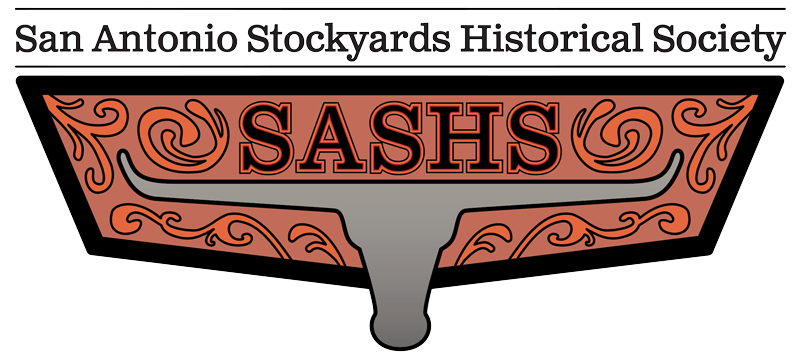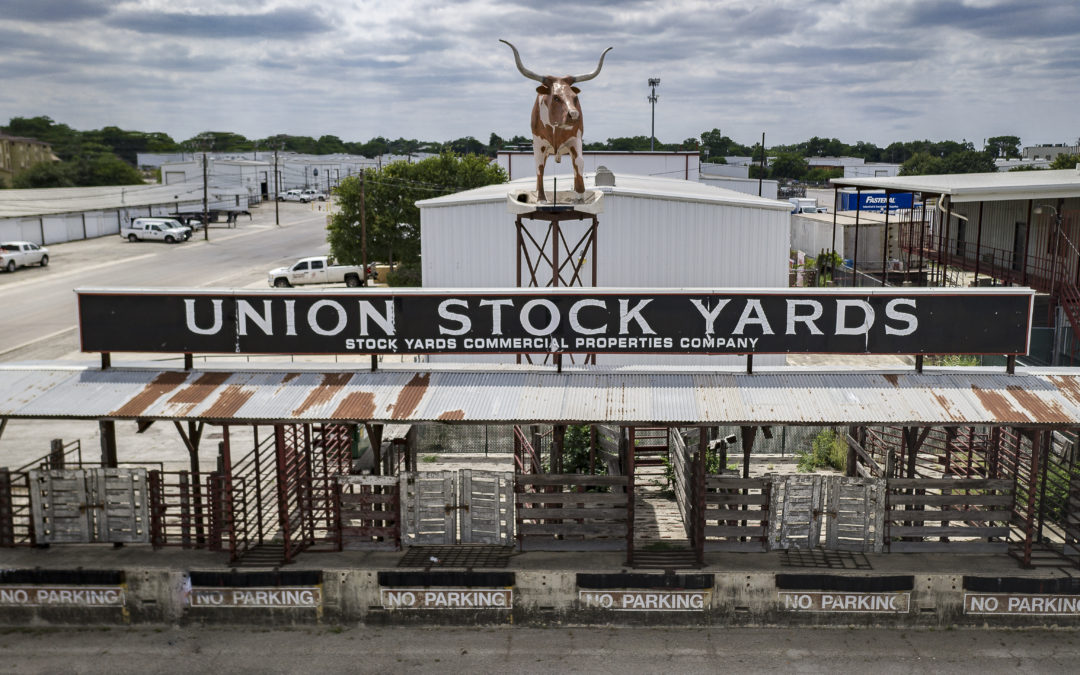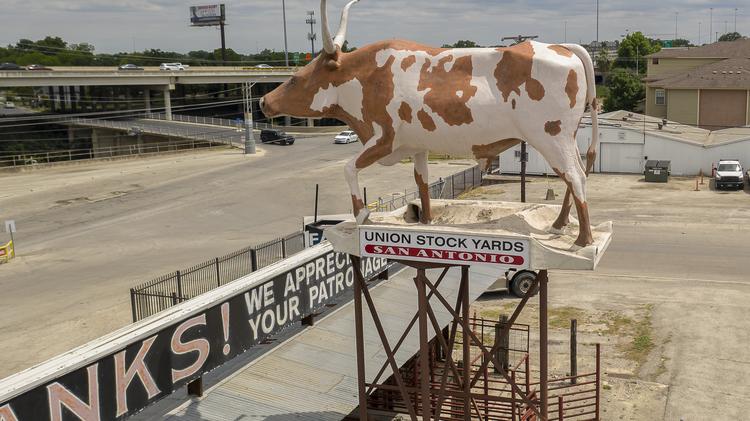“Are we at the rodeo, Tia,” 6-year old Bobby Acosta asked his Aunt Rosie as he and his cousin clambered into the wooden bleachers. “Yes, Mijo,” she replied, even though they were actually at the Union Stockyards in its heyday. “She didn’t have money to take me and her son to the San Antonio Rodeo, so she would dress us up in our cowboy hats, boots, Western shirts and take us to the stockyards. We’d sit on the edge of our seats riveted by the men working cattle.”
These adventures fueled Acosta’s yearning to grow up to raise and work with animals like these men, his heroes. The Union Stockyards held its last auction in April 2001 closing their doors to a 112-year history of livestock commerce.
A haunting echo the thousands of cowboys and animals flowing through the gates remains at the rustic wooden chutes on South San Marcos Street. They seem patiently lined up awaiting a time to welcome happy crowds back for a visit. The lonely long horn statue atop the Union Stockyards scans the vista. It’s as if he is watching the old ranch trucks and trailers winding their ways through the streets of downtown San Antonio to arrive at his majestic presence.
The raucous bleating of cattle. The earthy smell of fresh manure. The boisterous background shouting of cowboys, and the rapid-fire, barely comprehendible auctioneers are sounds still linked vividly with Acosta’s boyhood memories of the culture of the old cattle-market. Acosta was in his early 20s when the stockyards started shrinking due to urban sprawl. It broke his heart to see the former hub of activity begin to resemble a ghost-town. He remembers driving by the vacant location with a friend lamenting to her, “Why doesn’t someone do something with that place like they did in Fort Worth with their stock yards?”
“Why don’t you do it, Bobby?” the friend retorted.
When the San Antonio Stockyards opened in 1889, cowboys from local ranches drove their herds on horse-back into the stockyards.
Acosta’s life-long dream began with that suggestion. Within the last decade, he found like-minded businessmen who joined him and became board members to form the San Antonio Stockyards Historical Society, or SASHS, in October 2018. Acosta leads the nonprofit and wants to promote awareness of the forgotten stockyard and celebrate the roots of the cattle industry in San Antonio. The society’s board members support the preservation and awareness of the rich stockyard culture and want to rekindle stockyard traditions for people in generations to come. This rich culture and want to rekindle stockyard traditions for people in generations to come. This rich culture is the backbone of Texan character. It made the people industrious, creative, hard-working, and tough.
Fort Worth Stockyards Museum Director Teresa Burleson endorses the SASHS writing, “People from all over the world know about Texas and its connection to the cowboy. When they travel to Texas , that is what they want to see. What better way than to show them a small representation of a cattle drive down the street in San Antonio?” She further outlines the economic impact of the Stockyards Historic District in Fort Worth on her city’s economy. Her 2016 figures are that the District has 8.8 million visitors, $2.3 billion in direct and indirect spending, 22,583 jobs supported by tourism, and a $116 million in local tax revenue for Fort Worth.
The former home of the Presnall family, one of the original San Antonio Stockyard’s owners, is on the Texas Land Heritage Institute (TLHI) property at 1349 Neal Road. Presnall started with 187 acres in 1852, and the ranch was improved by the Watson family in 1882. The white wooden two-story house is being restored and converted into a museum space to house artifacts from the property, as well as from the Union Stockyards’ history.
The living history farm and ranch lends itself to horse riders revisiting the way horsemen navigated the country back in the early days of Texas. They have modern paved bike paths for hikers and bikers as well, and amenities for meetings and restroom facilities. The connection between the SASHS and TLHI is a strong working relationship that has just begun to develop and deepen.
SASHS vision is to establish a mixed-use venue somewhere in the urban San Antonio area that will host a 30-40 head cattle drive, trail rides with chuck wagon meals and camping, cowboy poetry and storytelling programs. The San Antonio Chamber of Commerce, the Texas Hispanic Chamber of Commerce, Bexar County Sheriff Javier Salazar, Westside Development Corporation, Agricultural FFA Education, Senator Donna Campbell, and Urban Advisory Services are members of the organization sharing Acosta’s enthusiasm about the inception of this organization, and the promise it holds for future business development and tourism.
When the San Antonio Stockyards opened in 1889, cowboys from local ranches drove their herds on horse-back into the stockyards. Andrew Schweers, a Quihi-area career cowboy talked about it when he was 93 years old. The recording captures his account of those days before 1920 when he and his brother drove small herds of cattle from a ranch north of Quihi to the stockyards on horse-back a few times a year. The trip would take two days and two skilled cowboys. They followed old highway 90.
A haunting echo of the thousands of cowboys and animals flowing through the gates remains at the rustic wooden chutes on South San Marcos Street.
One man led while one brought up the rear. When they got to the outskirts of San Antonio, a stock yard cowboy met them and led them through the city to the pens, then named San Antonio Stockyards. The lead cowboy stopped traffic allowing another cowboy to take the lead. When the herd was past the intersection, a cowboy would advance ahead of the herd to the next intersection. “The drive in wasn’t so bad,” Schweers says, “But by the ride home you were tired. We’d leave the stockyards about 2 in the afternoon and get back to Quihi at about 11 at night. By Castroville, you were pretty sick of being in the saddle.” Cattle drives diminished in the 20th-century as towns and populations in Texas grew, and shipping methods changed from drives and rail cars to diesel cattle trucks and internet sales.
Dr. Ricardo Romo, retired president of UTSA and board member of SASHS writes, “At the turn of the century San Antonio emerged as a logical meat processing alternative for ranchers from the South Texas region. The newly constructed Missouri Pacific lines enabled ranchers from South Texas, especially from Corpus Christi and Laredo, to increase significantly their shipment of livestock.”
The New York Times interviewed 40-year veteran auctioneer Bert Reyes in 2001 when they shut down the auction. Reyes said, “We moved from 10 to 15,000 head of cattle a week through here, shipping them out by rail all over the country.” The shipyard and adjacent meat processing and distribution plants were located on the west side of San Antonio. The majority of the people employed there lived in the neighborhood surrounding them. Thousands of people and generations of family members worked and participated in this agricultural way of life that revolved around selling livestock and processing it.
Betty Spellman Detmer, Longhorn breeder and volunteer with SASHS, agreed to lend some of her longhorn herd for SASHS events, “Thank you for preserving this history. My great grandfather drove
cattle to the San Antonio Stockyards from Karnes County,” she shares. July 1 members of SASHS met in Freer, Texas at Ty Detmer’s ranch to work the longhorns on horseback.
Many cattlemen fondly remember the festivity and excitement of attending auctions at the stockyards with fathers, grandfathers, mothers and siblings. Adrian Knight, a licensed auctioneer, has volunteered his talents for fundraising events to SASHS saying, “…I have fond memories of attending sales at the stockyards with my dad.”
Acosta feels passionately about enabling underprivileged students learn trades and skills that can earn them a living in the future. He elaborates, “One of the lessons the Covid-19 pandemic taught us as a society is how heavily we rely on agriculture to survive. Having the skills to raise your own food, as well as raise food for others, has become a blessing we should no longer take for granted.”
Burleson ends her endorsement letter for SASHS with this statement about The North Fort Worth Historical Society and Stockyards Museum, “It was started by a handful of people that had that ‘Texas Determination’ to preserve the history and legacy of the Stockyards and north Fort Worth. We see that same determination in the San Antonio Stockyards Historical Society.”
Become a member of the San Antonio Stockyard Historical Society to directly affect the preservation and awareness of the rich stockyard history and promote the grassroots importance of agriculture in Texas. For more information see www.sashs.org or call 210-872-8423.
For over 50 years, Uvalco Supply has been providing local landowners, farmers and ranchers with materials and supplies necessary for a wide variety of applications: game and livestock fencing, new and used pipe, structural steel, gates, cattleguards, livestock & equipment trailers, water system components and metal building materials.



